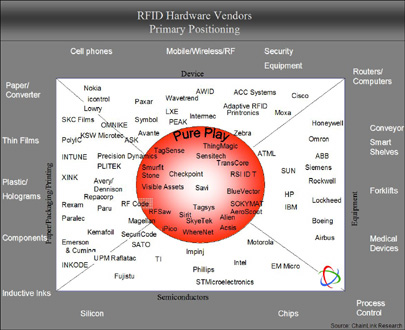Jul 03, 2006ChainLink Research has been researching the RFID market for several years, focusing on user needs and adoption. What has become obvious along the way is that a company's knowledge of the technology often does not match the needs and opportunities RFID can provide in terms of transforming its processes and business.
In addition, some vendors' knowledge is very limited to their particular product segment. Naturally, they will communicate to the customer the value of their solutions, but those products may miss the mark of what the customer actually needs. In addition, users are selecting technology without much understanding of what we call the "whole solution." In order to have a healthy market, these mistakes need to be avoided.
RFID's Supply Chain
RFID devices, like most electronics, are manufactured across a chain of value-adding steps. Depending on your company (whether an RFID technology provider or end user)—even if you are buying directly from a label converter, printer company or consultant—you need to know what is required at each stage to meet your business requirements.
Generally, at the right end of the chain, you will work with a converter or a distributor of auto-identification solutions. However, this is not always the case. Many end-user firms need highly customized solutions due to the nature of their product, its packaging, the environment in which it operates in and the solutions it offers. Thus, you might find yourself buying from or partnering with the upstream side of the RFID supply chain.
If you think about the "charter" of RFID use—sensing, identifying and communicating information—you can understand the rich market of players presently offering RFID solutions. We like to use the term primary positioning, since many players operate in a variety of solutions areas.
For successful buying, you just have to invest the time to understand how RFID works. Some common misconceptions on RFID can be shattered here:
- Certain frequencies don't work with certain materials. In reality, this can be sometimes solved with custom antennas.
- Active tags are expensive. If you think about RFID in cost per use, however, the cost can actually be quite low.
- Passive tags are not reusable or long-lived—it's in the packaging. Rugged tags have been in use for years.
- A reader or interrogator is a single-purpose auto-ID device. Today, cell phones, PDAs and other devices can function as RFID interrogators, so think about what you are going to do with it.
- Customers won't embrace RFID. On the contrary, they most certainly will.
Here are some key points to think about when implementing RFID:
- Run a pilot before you buy, and try to account for environmental factors—not only in your facilities, but also across the process—as well as the materials used in your products. You may need a customized tag antenna to make UHF work. Look into this—it is cheaper than you might think.
- In addition, think carefully about the management of the technology—that is, a process for dispensing, maintaining and managing devices. Plan for growth, and for the unpleasant issues of "disappearing" devices and other security breeches. Consider performance requirements (speed, distance and so forth); scalability; and growth in terms of understanding and increased functional requirements.
- Get your trading partners involved—if you are sharing a process, RFID has to work for all of you.
- Consider building your own little lab—this is not expensive, and if you are going to use RFID for many activities, you can build up the knowledge of RFID in your organization.
- Gain the necessary knowledge—take classes, and learn to work with and experience RFID.
There are many key factors to consider before choosing the best RFID technology and solutions for your company. Increase your confidence and unlock your creative side in gaining hands-on experience with RFID.
Ann Grackin is the CEO of ChainLink Research, a firm dedicated to helping executives improve business performance and competitiveness through superior business practices and technology. The research report on which this article is based can be purchased by visiting the company's RFID Technology Series Web page.



